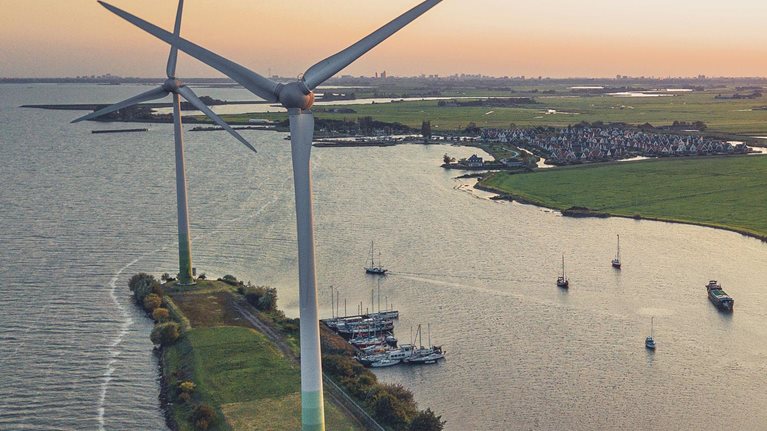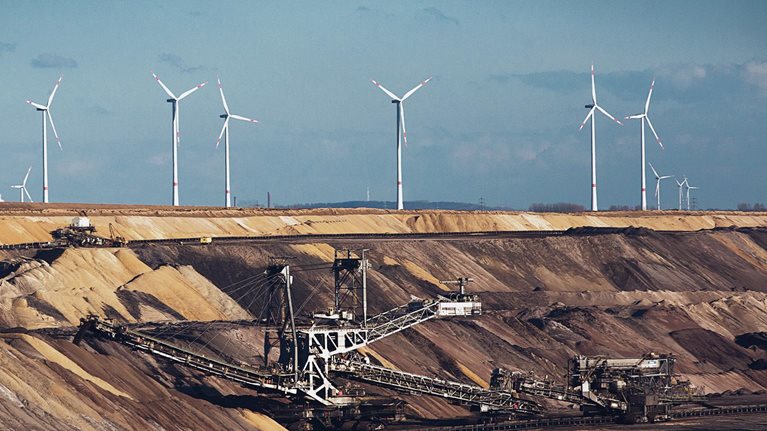The mining industry is at a tipping point where sustainability and decarbonization are top items on CEOs’ agendas. To achieve a 1.5°C climate-change target by 2050, the mining industry will need to reduce direct CO2 emissions to zero. Encouragingly, our analysis shows that solutions to decarbonize the majority of emissions will become economic within this decade, addressing both Scope 1 and Scope 2 emissions.1
The mining industry contributes 2 to 3 percent of global CO2 emissions and has a large role to play in emissions reduction. Within the industry, much of the focus to date has been on portfolio shifts (that is, divestment of coal assets); however, the industry is facing increasing pressure from regulators, investors, and customers to decarbonize operations. The sustainability of miners is increasingly a focus for the capital markets, with access to capital now more frequently dependent on sustainability. The cost of capital can be 20 to 25 percent higher for those miners with the lowest ESG scores.2 Simultaneously, customers are exerting increasing pressure. For example, most of the largest automotive OEMs have set ambitions for material decarbonization. This has led to substantial initiatives, such as the launch of H2 Green Steel in Sweden—the world’s first zero-carbon steel producer. It will demand zero- or low-carbon iron ore to feed into production.
Many of the largest miners in the world have been taking action by setting increasingly ambitious targets for their CO2 emissions. For example, since 2020, BHP and Vale have been targeting a 30 percent reduction in Scope 1 and 2 emissions by 2030; Rio Tinto is targeting 15 percent. While these are a big step change for the industry, the targets for net-zero carbon emissions are much further out (2050 for most players).
We believe now is the right time for miners to take action and accelerate their efforts to decarbonize, using this as a differentiator toward customers. Given this growing ambition for decarbonization, we set out to explore the current state of the industry, to build a robust fact base on what it would take to decarbonize aggressively so as to achieve the 1.5°C climate-change goal,3 and to understand related costs and the investments required. The following analysis is focused on the mining of metals (copper, gold, iron ore, and so on) and excludes coal and fugitive methane.
Breakdown of current mining emissions
Emissions within mining can be broken down into three broad types: Scope 1 (emissions from diesel), Scope 2 (emissions from electricity generation), and Scope 3 (emissions from the supply chain and transport). Today 40 to 50 percent of CO2 emissions come from diesel used in mobile equipment, with another 30 to 35 percent from nonrenewable electricity. However, the emissions intensity varies widely across mines: for example, within copper and iron ore, we see a twentyfold spread among the emissions intensity of mines (Exhibit 1).

To understand this variation, we have created a comprehensive mine-decarbonization model. This breaks down mining emissions at an equipment level and assesses more than 20 decarbonization options (Exhibit 2). We have used an iron ore mine in Australia as an example to see what the world’s first zero-carbon mine could look like.

In this particular example, haulage trucks are the single biggest source of emissions from the mine (accounting for 20 to 25 percent of the total), followed by comminution or crushing equipment (approximately 20 percent of emissions), bulldozers (7 percent), and excavators (5 percent). Addressing carbon emissions from these four types of equipment offers a substantial opportunity to make a step change in reducing overall mining emissions.
Decarbonization options
Multiple efforts will be required to address the principal sources of emissions and to decarbonize. Such actions include a move toward sustainable sourcing, fuels, and drivetrains, as well as a switch to green electricity. The following options are at varying states of technological readiness; several are already cost-positive today or will be by 2030 (Exhibit 3).
- Scope 1 and 2: improve operational efficiency. Modest investment in upgrading operational efficiency from average to top-quartile or benchmark levels via improved process and performance can generate cash flow to invest in alternative drivetrains or operations modifications.
- Scope 1 and 2: sustainable fuels. Several options exist for the mobile equipment used on the mine. For example, switching to liquid sustainable fuels (biofuels or synfuels)4 has the potential to decrease carbon emissions by more than 70 percent, even using existing equipment and infrastructure. However, this will come at a small cost, increasing total cost of ownership (TCO) by 10 to 15 percent today and approximately 5 percent by 2040.
- Scope 1 and 2: sustainable drivetrains. To go fully carbon neutral, a shift in drivetrains is required, with both hydrogen fuel cells and battery electric vehicles (BEVs) being possible long-term options. Different players are actively looking into this: Boliden has already set up a pantograph-charged hybrid at Aitik; Anglo American is developing a 300-metric-ton fuel cell electric vehicle (FCEV) haulage truck; and Newmont Goldcorp has set up the world’s first fully electric mine at Borden.
- Scope 2: green electricity. Switching to a green source of electricity addresses between 30 and 50 percent of current emissions output and is a must if electrifying processes is the chosen path to decarbonization. Several alternatives at different levels of complexity are available, from purchasing green electricity to installing and saving renewable energy (for instance, using photovoltaic solar panels). Several large-scale initiatives are already under way to shift mines to fully renewable electricity. For example, Rio Tinto’s Gudai-Darri mine will have 65 percent of its total electricity consumption supplied by a combination of solar farms and battery storage.
- Scope 3: sustainable sourcing. Moving entire supply chains toward greener operations is a challenge that the industry needs to tackle, and this will happen sooner rather than later as OEMs pressure for decarbonization. Key consumables included in this category are cement, steel, and lime.

One opportunity—the decarbonization of haulage trucks—could reduce a mine’s emissions by up to 25 percent. As such, this is one of the most critical actions to take. In the short term, the most significant approach will be the use of sustainable fuels (such as biofuels); however, substantial scale-up of biofuel production will be required to meet industry demand. Long-term switching from today’s diesel-powered trucks to either pantograph-charged BEV trucks or hydrogen fuel cell trucks will be the most favorable options from a cost and adoption perspective (Exhibit 4). We estimate that by 2030, TCO for a BEV or FCEV haulage truck will be approximately 20 percent, and 10 percent lower than existing diesel trucks thanks to 20 to 30 percent lower maintenance costs and 40 to 60 percent lower fuel costs, as compared with diesel despite higher upfront vehicle and infrastructure costs. Such a move will likely require changes to the design of existing mines, as well as commercialization of these types of vehicle (which today are only at the pilot stage). Nevertheless, if this approach is implemented in greenfield sites, there is a significant opportunity for substantial reductions in both carbon emissions and cost.

Looking across all of these potential decarbonization opportunities, we found that solutions to decarbonize the majority of emissions will be economic within this decade (Exhibit 5). That said, much of the opportunity is limited by technology availability and other operational considerations that need to be refined on a case-by-case basis. In practice, there is a huge opportunity for miners both to decarbonize and to reduce costs once these barriers are overcome.

Possible pathways toward the zero-carbon mine
There are several potential routes to achieving zero-carbon mines sometime between 2030 and 2040, including BEV and hydrogen pathways. These will require significant mine-level investments—typically $100 million to $130 million for a 25 million metric ton run-of-mine (ROM) facility—as well as an accelerated technology push and commercialization of the technology. There are short-, mid-, and long-term opportunities for decarbonization.
Short-term decarbonization actions
Focus on cost-positive alternatives with technology available today to ensure no-regret moves. Improve and take your operations to top-quartile levels; search for green energy alternatives and purchase them if available, or invest in renewable capacity; and switch to existing drop-in sustainable fuels. During this first stage, up to 60 percent of emissions can be reduced over the next three to five years.
Mid- and long-term opportunities for achieving zero carbon
These all need technological development not yet commercially available. The following three options all offer routes to sustainable mining, though the precise selection depends on operational characteristics and some forthcoming industry developments:
- BEV pathway. Move to a fully electric mobile equipment fleet, with haulage trucks charged on pantograph and others charged using a battery-swap approach.
- Hydrogen pathway. Use an FCEV mobile fleet, combined with a buildup of green hydrogen capacity derived from wind or solar.
- Synthetic fuel pathway. Keep existing equipment, but use drop-in synthetic fuels created from green hydrogen and carbon capture, utilization, and storage (CCUS).
Decarbonization presents a significant opportunity for ambitious players to differentiate themselves and lead the way toward zero-carbon mining. For this to happen at scale across the industry, multiple stakeholders (including mining houses, OEMs, suppliers, oil and gas players, commodity customers, and others) need to work together to develop the potentially cost-positive abatement approaches that are currently unavailable.

